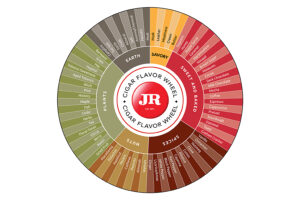There are many reasons why people fall in love with cigar smoking, but perhaps the most prevalent is the vast diversity in tastes and flavors that cigars can provide.
However, you might be wondering, “What do cigars taste like, exactly?” If you are a beginner just starting your journey in the world of premium handmade cigars, picking out individual notes of a cigar’s flavor profile can be challenging.
Whether a simple product page or an in-depth cigar review, you will see countless descriptors used for a cigar’s flavor. The taste can be vastly different depending on what makes up the components of the blend, which are the wrapper, binder, and fillers. Different seed varietals, growing regions, primings, and fermentation time, and how they combine in a blend all affect a cigar’s flavor.
You have probably noticed the difference in the flavor of the various cigar blends, even if you might not yet be able to discern what those differences are. A given cigar might be airy, smooth, and mellow, while another can be dense and bold, and you can probably tell they have different flavor notes even if you cannot pick them out. Identifying the flavors you are experiencing is the first step in becoming a true cigar connoisseur.
The JR Cigar Flavor Wheel
 2
2
How to use a Cigar Flavor Wheel
Across the internet, countless examples of flavor wheels are in varying degrees of detail. Flavor perception is also a subjective experience, so they will host a range of different categories and groupings. But what remains consistent with all flavor wheels, not only for cigars but also for coffee, wine, and chocolate, is that the flavors are separated and categorized into a few basic groups.
The more general flavors will be closer to the center, and around the outside of the wheel are more detailed, specific flavors. There are quite literally millions of unique flavors to pick out, so it’s impossible for any flavor profile chart or list to be totally exhaustive. Instead, a cigar flavor wheel will focus on the more common flavors you might experience while smoking a cigar.
For our JR Cigar flavor wheel, we wanted to break up the flavors into six simple categories, which are discussed in depth below. This is certainly not the only way to group flavors together, and several flavors can reasonably be grouped into multiple categories. Flavor perception and categorizing aromas are subjective, so you may not be in total agreement with the groupings in our JR Cigar flavor wheel.
Similar flavors are placed near each other in the outside tier, including from group to group, while flavors with greater differences are further apart. Again, this is not an exhaustive list of all the possible flavors you might experience, nor is it an exact science. Still, it gives you an excellent starting point to help you identify cigar flavors and how they combine to create complex flavor profiles.
How to “Taste” a Cigar
To learn how to taste a cigar, we must first determine exactly what it is people are talking about when they discuss what they are “tasting”, which is the flavor.
The flavor is a composite of both tastes and aromas built by the brain to determine what the senses are experiencing. While it might not seem like it, your sense of smell plays the most significant role in determining the flavor of anything, let alone a cigar.
Taste itself is limited to the sensations of salty, sweet, bitter, sour, and umami (savory), while the rest of the flavor comes from aromas picked up by your olfactory system. You can test this out with any fruity candy that comes in various flavors. If you were to cover your nose and try the different flavors, you would likely be unable to tell them apart. They will all just taste sweet with a touch of sourness.
Once your nasal passages are free and clear, the differences in flavor will quickly become apparent. This is because as you chew the candies (or smoke a cigar), the aromas will waft up through the back of the nasal cavity to provide more sensory information about what is consumed. However, this is not to say the taste is not also important — a cherry-flavored candy will give a vastly different experience than a cherry-flavored cough medicine because the candy is sweet while the medicine is bitter.
Interestingly, aromas sensed through the front of the nose will also provide a different experience than aromas through the back of the nose. For example, cheeses like Limburger can smell rancid and unpleasant when taking a whiff, yet when eaten are delicious with a delicate flavor.
If you want to learn more about how aromas and smell pathways interact with each other to create flavors, the popular food YouTuber Adam Ragusea has a fantastic video discussing these topics, which you can watch here. He discusses the aroma of petrichor, the pleasant smell of rain after a dry period, and how the aroma is not nearly as pleasant and perceived as muddy or grimy through the back of the nose.
This is why you see cigar reviewers always raving about the necessity of retrohaling and why the smell of smoke trailing from the foot of a cigar might not be exactly the same as the flavors you experience while smoking.
Also keep in mind that, like perfumes and fragrances, a cigar’s flavor will have top notes, base notes, and finishing notes. Top notes are the first flavors you experience, base notes are the underlying and supporting flavors, and finishing notes are the flavors that linger on the senses after the smoke has left. You shouldn’t worry too much about these as they are more advanced levels of perception, but as you become more experienced and skilled with discerning flavors, these too will become more apparent.
Because of the way tastes and aromas are intimately intertwined when determining flavor, both tastes and aromas are often both represented properly.

What are the Cigar Flavors?
Now that you have a keen understanding of how we perceive flavor and how to use a cigar flavor wheel, let’s get into the flavors you can expect from your favorite cigars.
A cigar’s most basic, general flavors are spices, nuts, plants, earth, savory, and sweet, and baked. While savory and sweet are technically tastes, the aromas in these groups are typically associated with their respective tastes.
Depending on the blending of a cigar, it might have a flavor profile that hits only a couple parts of the flavor wheel, while other blends could hit every corner of the flavor wheel. This doesn’t necessarily make one cigar better than another — it depends on how the flavors are balanced and interact with each other, as well as you feel about a cigar and your enjoyment.
Spices
Spices are some of the most common flavors to be found in a cigar. When thinking of spices or spicy flavors, pepper frequently comes to mind, including black pepper, white pepper, and red pepper. However, there are far more spices you might be able to detect, such as anise or licorice, cinnamon, vanilla, ginger, and clove
Spice flavors are often given more detail in the form of peppery spice, sweet spice, or baking spice. Pepper flavors like red pepper, paprika, and cayenne contribute to a peppery spice, while baking spices can encompass spices like cinnamon, nutmeg, and allspice. Sweet spices include flavors like vanilla and licorice.
Cigars made with Corojo and Habano tobaccos tend to have abundant spice flavors. Nicaraguan tobaccos are also associated with spiciness, but are diverse and can hit many areas of the flavor wheel. Notable examples of cigars with a spice-forward profile would be the Romeo y Julieta Crafted by A.J. Fernandez and My Father La Opulencia.
Nuts
Perhaps the most straightforward flavor category to pick up on is nuttiness. There are many different kinds of nuts, like peanuts, almonds, cashews, and pistachios, but they all have similar, distinctly nutty flavors. You may have already been able to pick up a general nuttiness while smoking cigars — although nuttiness is ambiguous and tough to describe, it is an easily distinguishable and recognizable group of flavors. Roasted nuts is also a common flavor to find in a cigar.
Dominican tobaccos and Sumatra and Cameroon wrappers will often have a dimension of nuttiness. However, like Nicaraguan tobaccos, a leaf from the Dominican Republic is quite diverse and does not always have nutty flavors. The San Cristobal Elegancia, H. Upmann Vintage Cameroon, and the iconic Montecristo have flavor profiles featuring nuttiness.
Plants
Plants are a wide category that could be broken up into more detailed sub-categories, however doing so would unduly complicate the flavor wheel. Plant flavors include various kinds of wood, fruits, herbs, grasses, and flowers.
Fruits are the most unique in the plant category thanks to their distinctive sweetness, and some cigar flavor wheels will even give fruits their own variety. Fruity flavors can range from dried fruits like raisins, stone fruit, and plums, berries like strawberry and blueberry, and citruses such as orange and lemon. San Andres and Connecticut Broadleaf can sometimes have fruity flavors along with their sweet taste. The La Flor Dominicana 1994 and Espinosa Laranja Reserva, for example, show off distinct flavors of cherry and citrus, respectively.
Woody flavors are typical in cigars, especially cedar. Cedar is one of the most frequently used cigar flavor descriptors, and oak, maple, and hickory can also be detected in a cigar’s flavor profile. Many famous brands like the Macanudo Gold Label and Romeo y Julieta Reserva Real exhibit woody flavor notes.
More grassy flavors like fresh-cut grass, hay, barnyard, and general vegetal flavors can also be present in a cigar’s flavor profile. These flavors can be found in Connecticut-seed tobaccos, like Connecticut Shade or Ecuadorian Connecticut, and are quite common in Candela-wrapped cigars such as the La Flor Dominicana Double Claro.
Aromatic plant flavors like various herbs and flowers can be found in cigars as well, however, they are not as common as other flavors. While uncommon, herbaceous flavors like mint, basil, tea, and lemongrass can sometimes make an appearance, as well as floral flavors like rose and lilac.
Finally, tobacco is the plant flavor you are likely most familiar with. While this article is about the wide-ranging flavor profiles that cigar tobaccos have, it would be a mistake to not include it on the flavor wheel. Aged tobacco can have different flavors from fresh tobacco and can have varying degrees of pungency and sweetness. However, they all share that same distinct tobacco flavor that all the other flavors revolve around.
Earth
General earthiness is one of the most common flavors you will experience in a cigar, but there are a few different earthy flavors you might experience. For example, damp earth and soil have a slightly different flavor than dry earth or mustiness. Various minerals, chalk, metals, and salt also fall into the earthiness category. They are from the earth, after all!
Like savory and sweet, salty is also technically a taste and not a flavor, but because there are few ‘salty’ flavors, it is categorized along with earth. Campfire and general smokiness are also placed in this category due to their earth-like flavors. A common trait for Honduran tobaccos, some cigars that have an earthy flavor includes the Punch Grand Cru, Alec Bradley Magic Toast, and Montecristo Volume II: The Rendezvous.
Another flavor in this category to watch out for is the flavor of ammonia. The presence of ammonia’s chemical pungency is more than just a flavor note — it is a sign that the tobacco in your cigar has not been properly fermented. In addition, ammonia is sour with an acrid, off-putting aroma that can mar your smoking experience.
Savory
Savory flavors are another smaller group, but there are a couple of flavors in this category that are exceedingly common in cigars: cream and leather. Like most savory flavors, both leather and cream come from derivatives of animals. Wool, meatiness, butter, cream, and leather and their aromas are all derived from animals in some way or another, and all share a rich, savory base.
The cream is characterized by an incredible smoothness and richness that is often found in more mellow cigar blends, like those found in the ever-popular Montecristo White Series and Rocky Patel Vintage 1999. However, creamy and buttery flavors can sometimes show up in bolder blends.
Leather is one of the most frequently occurring flavors in a cigar. Similar to cream, leather has a savory, smooth, and slightly earthy aroma that can be found in the mellowest of cigars to the most full-bodied. The incredibly popular Padron 1926 Series has an exceptionally complex profile, with leather being one of the lead flavors.
Sweet & Baked
Last but certainly not least is another wide-ranging group of flavors, sweet and baked. Like the plants’ category, sweet and baked flavors could be broken up into sub-categories like confections, grains and baked goods, and chocolate and coffee. However, with the exception of chocolate and coffee (which often have sugar added), they all have an underlying and unifying characteristic of sweetness.
While honey can be frequently found as an added flavor in affordable machine-made cigarillos, handmade premium cigars sometimes have a honey-like sweetness. Closely related to honey are other flavors of sugars and confections like brown sugar, caramel, maple syrup, nougat, marshmallow, and molasses. You can expect caramel sweetness from the top-rated Davidoff Signature Series or Oliva Master Blends 3.
An exceedingly common flavor found in cigars, especially those with Maduro wrappers, is chocolate. Chocolate can come in many forms, such as milk chocolate and cocoa, and while it does have a dimension of bitterness, it is often associated with sweets and desserts. Chocolate has a dark and intense flavor but is often accompanied by smoothness and sweetness, and can be enjoyed in cigars like the Trinidad Espiritu Series 2 and CAO MX2.
Closely related to chocolate is coffee, which shares a similarly dark, bitter flavor. Like chocolate, coffee is often mixed with creams and sugars to add more depth and dimensions to it. Coffee encompasses a variety of flavors like cappuccino, espresso, black coffee, and mocha, the latter being coffee mixed with chocolate.
Coffee is a popular added flavor in cigars as well, with Rocky Patel Java Red and M by Macanudo Coffee and Espresso being popular choices. The top-shelf Oliva Serie V Melanio also features prominent coffee flavors.
Rounding out the sweet and baked category are, of course, baked goods and grains encompassing bready or cereal-like flavors such as toasted bread, sourdough, pretzel, oatmeal, and graham crackers. These flavors tend to be a bit more subtle with a delicate sweetness and a sort of dry mouthfeel and are often perceived on the finish. Cameroon-wrapped cigars like New World Cameroon by A.J. Fernandez can have a toasty flavor, and the Foundation Charter Oak Connecticut blend has nuances of graham cracker.
In Conclusion
The next time you smoke a cigar, take your time with it and focus on the sensations you are experiencing as you smoke your cigar. Think about the aromas flowing over your palate and through your nose, and how they all add together.
It takes patience and experience to learn how to discern the flavors you are experiencing from your cigars. But now that you are equipped with knowledge on how to perceive flavors in general and the primary flavors to expect from your cigars, you are quickly on your way to becoming a bona fide connoisseur.

And I though all cigars were just stinky stoogies like the ones in th old tv commercials for air fresheners…. you know what … they should make an air freshener that smells like a “good” cigar andbygood I mean any cigar being smoked…. I realized stale cigar smoke is unpleasant but the same can’t be said for a burning cigar…you know what I mean
Very helpful information thank you